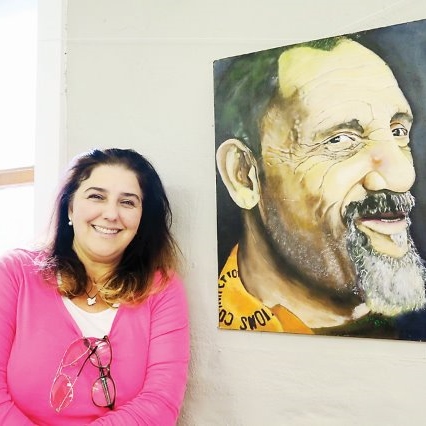click to dowload our latest edition
CLICK HERE TO SUBSCRIBE TO OUR NEWSLETTER


Published
5 years agoon
By
adminTALI FEINBERG
An Israeli who made her home in Cape Town, she is one of the few outsiders – and probably one of the very few women and Jews – who have voluntarily set foot in one of this country’s most notorious prisons.
“I grew up in a very religious family in Jerusalem, and my grandparents always told me that being a Jew is to have a heavy responsibility to bring balance and peace to the world. So, it comes from wanting to do mitzvot (good deeds) and tikkun olam (heal the world),” says Lang, who is herself a talented painter.
Lang came here on shlichut (commission) from Israel, and was welcomed by a man at the airport who would later become her husband. They lived in Israel for a number of years before settling in South Africa. As Lang made Cape Town her home, she realised that most people dealt with the problems in the country by building higher fences and bigger walls. While she doesn’t judge them for doing this, it didn’t sit well with her. Following the values of her Jerusalem home, she decided she wanted to play her part in changing society.
So, she started an art programme at Pollsmoor. “I faced a huge backlash from a lot of people, including the members of my own family. A rabbi even called to ask what I was doing. But this is what I felt I needed to do.”
She ran art workshops for ten years, and the prisoners were hugely receptive, respectful, and open to Lang’s teaching and message. “If I have managed to make even a small difference to one person, it would have been worth it,” she says. In addition to art, she taught yoga and breathing exercises, and hoped to train talented prisoners to teach others.
She witnessed the horrific living conditions at Pollsmoor, learned about prison gangs and systems to create order out of chaos, and even learned that prisoners have their own language. “When you go there, you have to leave everything else behind. It’s like entering another realm.”
It wasn’t without its challenges. Although Lang always felt safe and respected, she had to set up strict boundaries with the prisoners, who often expected her to help them with whatever they needed. She also had to deal with corruption in the system. Eventually, too many broken promises by those in charge led her to stop giving workshops.
Now, former prisoners come to her, as do other people on the margins of society. Her art gallery is located in the middle of Cape Town’s historic Bo-Kaap, and she has taught local children art classes. She has hosted a number of exhibitions for ex-prisoners, and hosts shows for established artists.
Lang once devoted a small section of her gallery to the very disturbing work of a female prisoner as a favour to the woman, never expecting any of it to sell. Yet, a man from England walked in and bought all the work.
Her latest project is an exhibition of etchings by ex-prisoner Joseph Buys (59), which has gained interest from newspapers, TV shows, and the public. Buys is a former gangster who has spent most of his life in prison, but is now trying to start afresh.
He makes intricate etchings of himself, and for 24 hours straight does not stop to eat or drink until the image is complete, says Lang. He has created at least thirty of these small but impressive works, as well as a large painting. Buys told Lang he draws himself as he has finally come to accept how he looks. Three etchings have already been sold, and she expects more to follow.
Lang has been invited to give talks, and wherever she has gone, she has found misconceptions about Jews, some deeply anti-Semitic. At a Women’s Day church gathering in Mitchells Plain, grown women asked her if Jewish girls menstruated, and if Jews got special powers on Shabbat. The bishop of the church told her that the Jews had an “excellent strategy” of spreading themselves around the world so that they could control it.
Prisoners told her they thought Jews were stingy, rich, arrogant, and isolated. None of this came from a place of hatred – it was just ignorance, says Lang. So, wherever she goes, she tries to educate people about Jews, and believes it’s urgent that the community does the same. With her gallery located in a historic Muslim area, she believes interaction with the local community is helpful in building bridges.
Meanwhile, she will continue to use art to heal, transform, and break down barriers. “Art is not a club for the rich and famous. It should be affordable and accessible, and we should not dictate who will be successful,” she says.
To the Jewish community, she says, “If we are supposed to be a light unto the nations, we all need to do at least one action a week to fulfil a mitzvah (good deed), and learn about what we are here for.” This doesn’t mean everyone has to go to Pollsmoor, it can be a small gesture like delivering challot (Shabbat bread) to needy Jews, visiting the sick, or caring for children. It can be in our own community or beyond, says Lang. “We need to come out of our cocoons, go somewhere dark, and spread a little light.”
